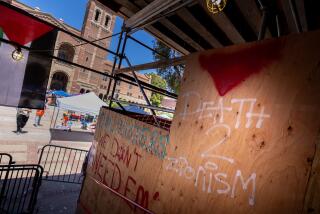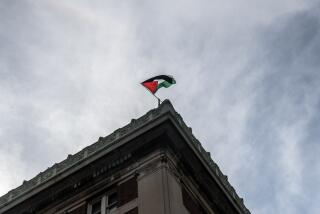Spoon Tells Tale of Suffering in Stalinist Camp
PEVEK, Soviet Union â A small silver spoon tells the story of thousands of prisoners who suffered in a Siberian labor camp set up under the rule of Josef Stalin in the Soviet Far East.
âWhen I eat, I say nothing and hear nothing,â reads an inscription scratched on the spoon, found amid a cluster of brick barracks and wooden crosses in a graveyard in the camp. It was signed with the name Volkov.
A recent visit to the camp, the first by foreign journalists, revealed conditions perhaps even worse than those described in the acclaimed works of Varlaam Shalamov and Eugenia Ginzburg, who endured the notorious Kolyma camps in Northern Siberia.
Located at the tip of the continent about 50 miles outside Pevek, the camp was given the name Severny, the Russian word for northern.
Even prisoners who managed to survive a starvation diet of bread and water, died from exposure to temperatures reaching almost 100 degrees below zero.
Set on a mountain overlooking the Arctic Ocean, the camp is an intimidating illustration of naked human power and cruelty.
A path still remains where emaciated prisoners assigned to work in a uranium mine were forced to climb an enormous stairway each day. The stairway connected a lower camp, where the mine was located, to an upper camp where the prisoners slept, at about 3,900 feet above sea level.
âEven though it would have made more sense to have the prisoners sleep near the mine, the authorities feared they would escape, so they made them live high atop the mountain,â said Nikolai Vasiliyev, a geologist who is studying the camp.
From 1950 to 1960, the years Severny was believed to have operated, about 20,000 political and criminal prisoners lived there at one time. Most survived an average of only two to four years.
The Severny camp is considered perhaps the most extreme example of human horror established during the Stalin period--a time of purges, show trials, fabricated plots, executions and mass exile.
No precise figure has been placed on how many people perished in camps throughout the Soviet Union. Western historian Robert Conquest has estimated that 20 million to 40 million people died between the early 1930s and the 1950s. Stalin died in 1953.
Efforts to destroy the Stalin legacy have prompted a public crusade in Siberia.
It began in 1986, after President Mikhail S. Gorbachevâs policy of glasnost lifted a shroud of secrecy that had surrounded the reviled dictator.
Now, in the port of Magadan, a city in Siberia built with prison labor and used as a depot for dispatching prisoners farther north, an organized effort is under way to identify camp survivors and to learn about camp history.
The effort is being inspired in part by some camp survivors who settled in Magadan when their exile ended.
Asir Sandler, 72, a former prisoner who was transported thousands of miles by train for a decade in camps in Azerbaijan, the Ural Mountains, the Far East and Siberia, tried to live in Moscow after his exile. But he found people were intolerant of his experiences.
âMy whole life is shaped by the camps, so I decided to return to Magadan,â said Sandler, a spirited man who had been sentenced to death, but wrote a plea for mercy and had his sentence commuted to 10 years.
Even for some Magadan residents who were never prisoners, the camps are carved into their childhood memories.
âThere was a camp near our house,â recalled David Reisman, 49, who was born in Magadan.
âWe would throw bread and cigarettes through the barbed wire for the prisoners and they would throw us toys. Then the guards would shoot into the air to scare us away,â he said.
Memorial, a national grass-roots organization with a chapter in Magadan, has identified at least 100 camp sites stretching from Magadan into the Far East.
A map of the suspected sites hangs in one corner of Magadanâs Pushkin Library. When survivors from across the Soviet Union come to the library, they are asked to indicate the location of where they were sentenced during the great purges.
âWe know so little about what happened even though Magadan was where thousands of prisoners marched through the streets,â said Meron Atlis, a camp survivor and president of the local Memorial chapter.
The group is planning to build a monument this year on the mountaintop at Pevek. A larger memorial complex is scheduled for Magadan, where a small monument now stands in the townâs central square.
Many camp survivors and their relatives are concentrating their search for the missing pieces to the labor camp puzzle in the Kolyma region.
Of all the forced labor camps during the Stalin era, Kolyma stood out not only for its cruel regime, but also for its high mortality rate.
Prisoners were forced to walk more than 250 miles in bone-chilling temperatures to the Kolyma camps from Magadan--a 14-hour journey by car.
During a recent trip to a camp on the notorious Kolyma peninsula, the only visible remains were brick barracks, barbed wire and rusted tin cups.
Camp survivors such as Alexandra Popova, 49, who was born inside the wire, the daughter of a prisoner, believes the state has not done enough for Stalinâs victims.
Despite the Gorbachev reforms permitting such groups as Memorial, Popova, who spent part of her childhood in Kolyma, wants compensation for the lost years.
âSocial justice is not yet here,â she said.
More to Read
Sign up for Essential California
The most important California stories and recommendations in your inbox every morning.
You may occasionally receive promotional content from the Los Angeles Times.










